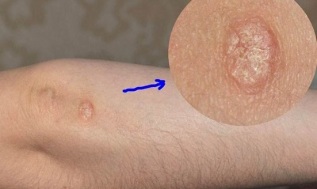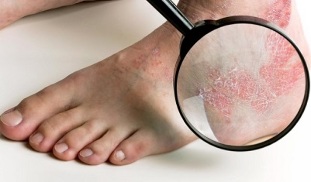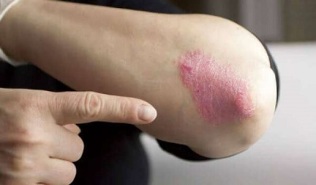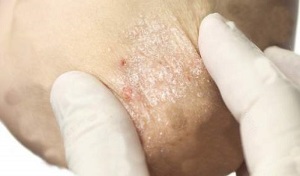Psoriasis is an inflammatory skin disease. Occurs when the immune system fails. The development of the disease is divided into clear stages - appearance, progression, stabilization, and regression. Different stages of psoriasis differ in the appearance of spots and rashes, itching pain, and extensive dermatitis.
Why differentiate between the stages of disease development and what are the characteristics of the course of psoriasis at the beginning of development and during healing?
Why you need to know the stages of psoriasis

The division of psoriasis into stages is used by physicians to make the right choice of therapeutic methods. The complex of drugs and external agents prescribed to treat inflammation depends on the stage of development of the disease.
General therapy is needed at the beginning of the disease - vitamin complexes, diet, external aseptic treatment of the rash, such as UV treatments. Also prescribed drugs that stimulate the cleansing of intestines, blood vessels, liver.
Be sure to correct your psychoemic condition - neuropathologist or psychologist.
In the early stages of the disease, no strong drugs are used that suppress the immune system, no hormonal ointments are prescribed. These drugs have a large list of side effects, so they should only be prescribed if it is impossible to do without them.
Psoriasis: treatment in acute stages and remission
In the acute, progressive course of the disease, several drugs with different effects are prescribed. Immunosuppressants and glucocorticosteroids are often used to relieve inflammation and reduce itching. External treatments are complemented by photochemical, ultrasound and laser therapy. Agents are also prescribed for the antiseptic treatment of damaged skin.
In a stable state, they continue to take anti-inflammatory hormonal drugs, gradually reducing their dose. Regenerating ointments are prescribed to repair damaged skin.
In remission - support the body. Proper nutrition, intake of vitamin and mineral complexes to restore immunity.
Timeliness of treatment
The earlier treatment is started, the easier it is to control psoriasis.

Timely therapy limits the spread of dermatitis, reduces its extent, and prevents subsequent relapses of exfoliation. Because it is often confused with an allergic rash in the early stages of psoriasis, the initial signs of not missing out on the appearance of skin disease should be known.
Note: Doctors are still investigating the causes of psoriasis. But it is definitely known that psoriatic inflammation of the skin is not contagious. A patient cannot be admitted and an infection cannot be acquired in the event of an injury. This is our own personal failure in the human body.
Psoriasis is caused by a lack of immunity, which can be caused by a variety of factors. Severe stress, poisoning (including strong drugs, industrial waste, alcohol), previous infection.
Psoriasis is difficult to treat. The disease is prone to recurrence. And the therapy itself is symptomatic. This consists of preventing the appearance of new spots and relieving existing itchy skin.
Which stage of psoriasis is called initial? How to distinguish between early psoriasis and diathetic rash? And how will the disease develop in the future?
Psoriasis: initial stage
The first appearance of psoriasis on the skin appears to be acne. Most often, the rash appears on the bend of the elbow and knee, or in places where the clothes are tight against the body (such as under the waist belt). Rashes can also appear on the edge of the hair and under the hair, around the nails and on the nail plates. Sometimes psoriasis occurs on the legs and palms.
Psoriasis is almost always symmetrical - on the elbows of both hands, or on the lower back, or on two knees.
The pimples themselves (in medical terminology - papules) have a modest appearance in the initial stages. They have:
- Pink or red;
- Sharp, blurred edge;
- Small size - acne on the base does not exceed two millimeters;
- Flat shape - small punctate pimples at the onset of the disease have almost no bulge, so they look mottled.
As the disease progresses, flaky skin flakes appear on the pimples. Gray or silvery, they appear white in the background of a red pimple.
The appearance of scales is quite severe with itching. If it doesn’t resist and scratch, the scale is removed and reveals shiny areas of pink young skin underneath. Very thin, fragile, itchy papules are associated with long-lasting scratches - damaged, bleeding.
The initial stage of psoriasis lasts up to four weeks.
Psoriasis: the stage of progression

In the progressive stage, each acne merges into a common spot, forming so-called psoriasis plaques. They rise above the surface of the skin and are almost completely exfoliated. There is a non-exfoliating pink-red rim on the edge of the psoriasis plaques.
The presence of a rim is a sign of a progressive stage of the disease. The width of the rim is one or two millimeters. The skin on it is inflamed, resembling parchment in structure.
Edge is the expansion area of the spot. This is the skin that is already inflamed but not yet peeling. After a while, the scales also cover it. And the patch expands to cover new areas of skin and form a new wider rim.
As the disease progresses, adjacent spots merge with each other. At some point, a large, inflamed red spot may form on the human body.
Psoriasis plaques are very itchy, cause discomfort in the person, disrupt their work, rest and sleep. They grow, occupy a large area, and form a new rash on clean, healthy skin.
The main sign of the progressive stage is the appearance of new rashes. As soon as new pimples and blemishes do not appear, the next stage of psoriasis begins - standing. It’s not a complete victory yet, but it’s already a turn toward recovery.
In the stage of progression, psoriasis is almost always accompanied by weakness, fatigue and weakness. Depression is common. Temperature possible.
Note:Some medical theories claim the opposite. Depression is not a consequence of psoriasis. And psoriasis is a consequence of neurology, the depressed psyche.
The duration of the progressive phase of psoriasis can be long, several months.
Psoriasis: standing section

The main sign of the standing section is the disappearance of new spots and rashes. However, the itching also decreases, becoming more tolerable. The rash loses its vibrant color, becomes discolored, becomes invisible. This is also a sign of stabilization of the process.
The pink rims around the plaques disappear as the inflammation continues to spread. Active exfoliation and healing, the regeneration of new healthy skin, begins.
It is noticeable to the naked eye that exfoliation increases in the standing phase. The scales completely cover the entire surface of the psoriasis patch, leaving no room for the rims.
Psoriasis has a characteristic scaly appearance that is generally recognized by the general public. Extensive peeling in the standing section is not dangerous.
When all the dead cells detach from the surface of the psoriasis patch, a light light shade of healthy skin remains in place.
Other signs of progression or stabilization
In addition to the appearance of rash, spots, and scales, there are a number of other signs that can be used to assess the development of the disease. This is the itching (strong or tolerable) feeling, the general condition, the nature of the depressed mood. And the presence of temperature as well.
In the initial stage, the itching is variable, the rash is incomprehensible. Furthermore, the itching increases every day. In the acute stage of psoriasis, it becomes unbearable. It disrupts sleep, rest, disrupts work. The person will be irritable because the itching does not allow for rest.
In the standing section, the itching subsides. Every day - one feels better. The general state of the psyche changes, negativity and depressed moods weaken. The duration of the standing phase is several weeks - from 2 to 5.
Psoriasis in the attenuation phase

Fading of psoriasis is the almost complete disappearance of plaques, blemishes, redness, inflammation, and itching.
At this stage of the disease, psoriasis is just reminiscent of different pigmentations of the skin. It appears brighter at the site of the former psoriatic spots. The surface of healthy skin has a darker shade.
In some cases, so-called hyperpigmentation develops. In place of psoriasis spots, the skin will not become lighter but darker. In any case, the differences in skin pigmentation will be visible for another month or two.
Psoriasis after recovery: the possibility of relapse
The chance of a relapse of psoriasis is determined by a person's lifestyle, diet, allergic mood and the condition of the body as a whole. It is also determined by the amount of toxins in your body, blood and liver. You can reduce the likelihood of recurrent dermatitis by strengthening your immune system and cleansing your body of toxins in the liver, blood vessels and intestines.
Seasonal relapses of psoriasis after cleansing are often rare. A person is still susceptible to the disease, but the likelihood of its occurrence is noticeably reduced.
Cleansing the body of toxins and ingesting vitamin and mineral complexes will help boost immunity. This is especially important if immunosuppressants have been used during treatment in the progressive stage of psoriasis. Their need was due to the work of inflammatory mediators. After suppression of autoimmune defense, the immune system must be restored.























